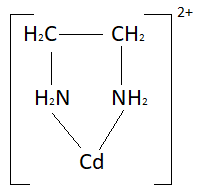
What is meant by the chelate effect? Give an example.
Answer
579k+ views
Hint: Chelate is a term related to coordination compounds. When a di- or polydentate ligand uses its two or more donor atoms together to bind a single metal ion then it is said to be a chelate ligand. The number
of such ligating groups is called denticity of the ligand.
Complete answer: When a ligand is bound to a metal ion through one single donor atom then it is called unidetate but when it uses two donor atoms it is said to be a bidentate ligand. $C{l^ - }$ , ${H_2}O$are unidentate ligands and ${C_2}O_4^ - $ , ${H_2}NC{H_2}C{H_2}N{H_2}$are bidentate ligands. Similarly ligands having more than two donor atoms are called polydentate ligands $N{\left( {C{H_2}C{H_2}N{H_2}} \right)_3}$is a polydentate ligand. When a di- or polydentate ligand uses its two or more donor atoms together to bind a single metal ion then it is said to be a chelate ligand. When a ligand uses its two or more donor atoms simultaneously a ring-like structure is formed. The formation of such ring-like structures is called a chelate effect. Compounds having chelate rings are more stable as compared to other compounds. An example of such a complex is ethylenediamine-cadmium. The structure of this complex is:

Note:
The coordination number of the metal complex is defined as the number of ligand donor atoms to which metal is directly bonded. The central atom/ion and the ligands attached to it are enclosed in a square bracket and the term collectively used is the coordination sphere.
of such ligating groups is called denticity of the ligand.
Complete answer: When a ligand is bound to a metal ion through one single donor atom then it is called unidetate but when it uses two donor atoms it is said to be a bidentate ligand. $C{l^ - }$ , ${H_2}O$are unidentate ligands and ${C_2}O_4^ - $ , ${H_2}NC{H_2}C{H_2}N{H_2}$are bidentate ligands. Similarly ligands having more than two donor atoms are called polydentate ligands $N{\left( {C{H_2}C{H_2}N{H_2}} \right)_3}$is a polydentate ligand. When a di- or polydentate ligand uses its two or more donor atoms together to bind a single metal ion then it is said to be a chelate ligand. When a ligand uses its two or more donor atoms simultaneously a ring-like structure is formed. The formation of such ring-like structures is called a chelate effect. Compounds having chelate rings are more stable as compared to other compounds. An example of such a complex is ethylenediamine-cadmium. The structure of this complex is:

Note:
The coordination number of the metal complex is defined as the number of ligand donor atoms to which metal is directly bonded. The central atom/ion and the ligands attached to it are enclosed in a square bracket and the term collectively used is the coordination sphere.
Recently Updated Pages
Why are manures considered better than fertilizers class 11 biology CBSE

Find the coordinates of the midpoint of the line segment class 11 maths CBSE

Distinguish between static friction limiting friction class 11 physics CBSE

The Chairman of the constituent Assembly was A Jawaharlal class 11 social science CBSE

The first National Commission on Labour NCL submitted class 11 social science CBSE

Number of all subshell of n + l 7 is A 4 B 5 C 6 D class 11 chemistry CBSE

Trending doubts
What is meant by exothermic and endothermic reactions class 11 chemistry CBSE

10 examples of friction in our daily life

One Metric ton is equal to kg A 10000 B 1000 C 100 class 11 physics CBSE

1 Quintal is equal to a 110 kg b 10 kg c 100kg d 1000 class 11 physics CBSE

Difference Between Prokaryotic Cells and Eukaryotic Cells

What are Quantum numbers Explain the quantum number class 11 chemistry CBSE




